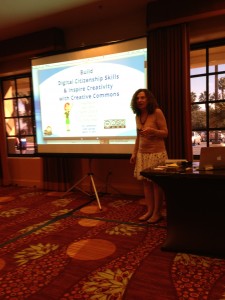
Last week I attended and presented at the CUE Conference in Palm Springs. The conference had record attendance of over 5,300 attendees as more and more educators see the benefit of this professional development opportunity. In fact, CUE previously was “shorthand” for “Computer Using Educators.” At this conference, the association announced a new logo, included in CUE’s Twitter header pictured above, and that the association name will now be simply CUE. “Computer Using Educators” will no longer be part of the name. The rationale? It used to be that teachers and other educators interested in computers and technology were in the minority. That’s no longer so. Now all educators need to be tech-savvy; they all need the kind of professional development that CUE offers.
Here are a few of my personal conference highlights and takeaways:
LeVar Burton, pictured in my screenshot of CUE’s new Twitter header above, was the Friday morning keynote speaker. Here are some of my Twitter “notes” from his inspiring session: (Be sure to scroll this text box to see all the postings.)
 As part of the conference, California School Library Association presented a “Digital Citizenship Summit” on Saturday. We were very fortunate to have Gwyneth Jones, aka The Daring Librarian, a middle school librarian from Maryland, as our lead speaker. In her session on “Secrets of the Remix Mash Up YouTube Generation” she shared that “Everything is remix; use it for engagement.” We all learn by repeating; we can leverage that and help students to be respectful remixers by working with the tools they already love, sharing other engaging tools with them, and teaching them about Creative Commons and attribution. Here’s a tweet shared by teacher librarian Sharlene Paxton during Gwyneth’s session:
As part of the conference, California School Library Association presented a “Digital Citizenship Summit” on Saturday. We were very fortunate to have Gwyneth Jones, aka The Daring Librarian, a middle school librarian from Maryland, as our lead speaker. In her session on “Secrets of the Remix Mash Up YouTube Generation” she shared that “Everything is remix; use it for engagement.” We all learn by repeating; we can leverage that and help students to be respectful remixers by working with the tools they already love, sharing other engaging tools with them, and teaching them about Creative Commons and attribution. Here’s a tweet shared by teacher librarian Sharlene Paxton during Gwyneth’s session:
To engage students, we need to be using tools like YouTube and great YouTube channels like Horrible Histories and the History Teachers Channels, while also introducing innovative tools such as Scoop.it for curation, LessonPaths for online lesson playlists, and Flocabulary for engaging learning through rap music.
The Digital Citizenship Summit also included Pam Oehlman on “Teaching Digital Citizenship by Crafting Quick Flipped Tutorials and Using Existing Resources,” Glen Warren on “The Uncommon Core: New Standards, New Literacies, and Student Significance,” and my session on “”Inspiring Creativity While Respecting Copyright with Fair Use and Creative Commons.”
Pam shared an analogy comparing the pencil to digital citizenship instruction; our kids today need the same careful instruction on using devices as we use to teach kindergartners the safe use of pencils. She shared lots of great resources for digital citizenship instruction, and you can see them reviewed in her presentation file.
All too often in school, Glen shared during his session, we don’t ask kids what they want to learn. Instead, we just tell them what they have to learn. One the great things about school libraries, is that we ask them what they want to learn, and we help them connect that to the literacies, including those covered in the Common Core, that they need to learn. Here is a graphic showing how information literacy, which librarians teach, crosses all curricular areas, including personal interest:

Glen advocated for giving students the same kind of 20 percent time that Google provides, allowing them to pursue their own interests in that time. He also shared how he makes students accountable for their time and has them simultaneously learn and practice information literacy skills. He uses a Google Form to have them submit information about their work, including the questions they asked and the research they did.
In my session, I focused on teaching respect for intellectual property, on understanding copyright and fair use, and on taking advantage of using Creative Commons material to make that task easier. I also advocated for contributing to a creative society by licensing our own works with Creative Commons licenses and encouraging our students to do the same. Here is the presentation file:
If you haven’t already joined the Creative Commons community, please do so! By sharing, we all contribute to a more vibrant, creative world. Gwyneth Jones included this powerful message in one her slides from her Friday session on “Marketing Your Program Like Lady Gaga”:

I tweeted a photo of the slide during her session, and it clearly resonated with many people, since I got lots of retweets.
I was also proud to be a part of CSLA’s booth presence in the exhibit hall, promoting what teacher librarians do:

Thanks to Sue Heraper for taking the photo of me (current Past President) with Janice Gilmore-See, current CSLA President, and Pam Oehlman, 2012-2013 President.
I came away from the conference bubbling with new ideas and some fun tech tips to share. Many of these are included in my Twitter feed (I’m @jane_librarian) from March 20-22, since Twitter has become my primary note-taking method during conferences. Also check the #CUE14 hashtag for a wealth of quotes from presenters, links to sessions and tools, and more. Thanks to all the presenters for their great ideas. I’ve captured only a fraction of them here. Also, thanks to CUE and Executive Director Mike Lawrence for enabling CSLA to present the Digital Citizenship Summit.









